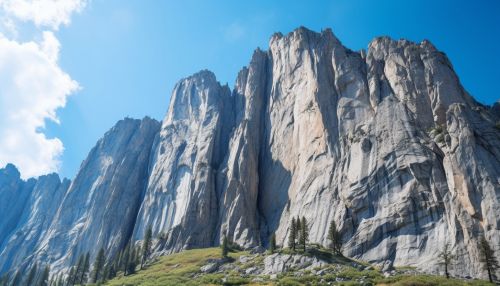Geology of the Yosemite area
Introduction
The geology of the Yosemite area is characterized by granitic rocks and remnants of older rock. The area around Yosemite National Park in the Sierra Nevada of California is underlain by granitic rocks at depth, which were formed from magma generated by the subduction of the Farallon Plate under the western edge of the North American Plate. The uplift of the Sierra Nevada and the erosion that followed have exposed these granitic rocks at the surface.
Geological History
The geological history of the Yosemite area can be divided into several periods, each of which has its own distinctive geological processes and rock formations.
Precambrian and Paleozoic Eras
The oldest rocks in the Yosemite area are metamorphic rocks that are from the Precambrian and Paleozoic eras. These include schist, gneiss, and quartzite, which were formed from sedimentary rocks that were subjected to intense heat and pressure.
Mesozoic Era
During the Mesozoic era, the area that is now Yosemite was part of a subduction zone where the oceanic Farallon Plate was diving beneath the North American Plate. This process generated magma, which rose to form a chain of volcanoes. Over time, the magma cooled and solidified to form granitic rocks, which make up the bulk of the Sierra Nevada today.
Cenozoic Era
In the Cenozoic era, the uplift of the Sierra Nevada and the erosion that followed exposed the granitic rocks at the surface. This process also created the distinctive landscapes of Yosemite, including its deep valleys, high cliffs, and domes.
Rock Formations
The Yosemite area is known for its distinctive rock formations, many of which are made of granite.
El Capitan
El Capitan is a prominent granite cliff that is one of the most famous landmarks in Yosemite. It is composed of a type of granite known as El Capitan Granite, which is characterized by large crystals of feldspar, quartz, and biotite.
Half Dome
Half Dome is another famous landmark in Yosemite. It is a granite dome that was shaped by the erosive forces of glaciers during the last Ice Age.
Cathedral Rocks
The Cathedral Rocks are a group of granite peaks that are located on the south side of Yosemite Valley. They are composed of a type of granite known as Cathedral Peak Granodiorite.
Glacial History
The Yosemite area has been shaped by several glaciations during the last 2 million years. The most recent glaciation, known as the Tioga glaciation, ended about 10,000 years ago. The glaciers carved out the U-shaped valleys and left behind many distinctive features, such as moraines, hanging valleys, and cirques.
Current Geological Processes
The Yosemite area is still being shaped by geological processes today. These include erosion by rivers and streams, landslides, and rockfalls. The area is also subject to occasional earthquakes due to the tectonic activity in the region.
See Also


